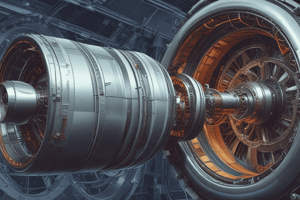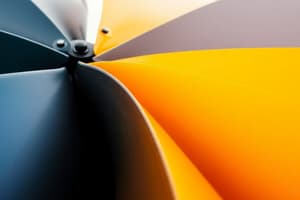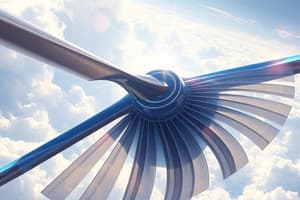Podcast
Questions and Answers
What material is used for the load-carrying member of a fiberglass blade?
What material is used for the load-carrying member of a fiberglass blade?
- Metal Spar (correct)
- Aluminum Ribs
- Foam Core
- Fiberglass Spar (correct)
What material is used to make the skins of a fiberglass blade?
What material is used to make the skins of a fiberglass blade?
- Roving
- Trailing Edge Foam Filler
- Aluminum Foil Honeycomb
- Fiberglass Cloth (correct)
What component is bonded to the trailing edge of a fiberglass blade?
What component is bonded to the trailing edge of a fiberglass blade?
- Fiberglass Cloth
- Trailing Edge Foam Filler (correct)
- Aluminum Ribs
- Stainless Steel Strip (correct)
What type of material is used for the fairing or pockets of a fiberglass blade?
What type of material is used for the fairing or pockets of a fiberglass blade?
What protects the leading edge of a fiberglass blade?
What protects the leading edge of a fiberglass blade?
What is the name of the shape of a rotor blade when viewed from above?
What is the name of the shape of a rotor blade when viewed from above?
What provides an attaching point to the rotor head?
What provides an attaching point to the rotor head?
What is bonded in place to transfer static electricity to the aircraft?
What is bonded in place to transfer static electricity to the aircraft?
What material is used to protect the leading edge of a wooden rotor blade from abrasion?
What material is used to protect the leading edge of a wooden rotor blade from abrasion?
What is a distinct advantage of a metal rotor blade?
What is a distinct advantage of a metal rotor blade?
How are metal rotor blades typically attached to the rotor head?
How are metal rotor blades typically attached to the rotor head?
What is a common characteristic of both wood and metal rotor blades?
What is a common characteristic of both wood and metal rotor blades?
Why are most wooden rotor blades made in matched pairs?
Why are most wooden rotor blades made in matched pairs?
What is the primary purpose of the aluminum pockets bonded to the trailing edge of a metal rotor blade?
What is the primary purpose of the aluminum pockets bonded to the trailing edge of a metal rotor blade?
What is a potential disadvantage of wooden rotor blades?
What is a potential disadvantage of wooden rotor blades?
What is the main reason that metal rotor blades have a life limit?
What is the main reason that metal rotor blades have a life limit?
Why is the bottom of a rotor blade painted black?
Why is the bottom of a rotor blade painted black?
What is the purpose of the mast in a helicopter?
What is the purpose of the mast in a helicopter?
What is a single-pocket or fairing blade?
What is a single-pocket or fairing blade?
What is the main disadvantage of a single-pocket or fairing blade?
What is the main disadvantage of a single-pocket or fairing blade?
What is the main advantage of a multiple-pocket or fairing blade?
What is the main advantage of a multiple-pocket or fairing blade?
What are some internal structural components of a rotor blade?
What are some internal structural components of a rotor blade?
What is bonding in the context of rotor blade construction?
What is bonding in the context of rotor blade construction?
What is the main difference between single-pocket and multiple-pocket rotor blades?
What is the main difference between single-pocket and multiple-pocket rotor blades?
What should be done with any rotor blade that has suffered nonrepairable damage?
What should be done with any rotor blade that has suffered nonrepairable damage?
Which method is used to protect the interior of a rotor blade from moisture and corrosion?
Which method is used to protect the interior of a rotor blade from moisture and corrosion?
How should the exterior surface of a rotor blade be cleaned?
How should the exterior surface of a rotor blade be cleaned?
What should be done prior to packaging a rotor blade?
What should be done prior to packaging a rotor blade?
What information must be included on the outside of the rotor blade container?
What information must be included on the outside of the rotor blade container?
What is the primary purpose of tail rotor blades?
What is the primary purpose of tail rotor blades?
What materials are typically used in the construction of metal tail rotor blades?
What materials are typically used in the construction of metal tail rotor blades?
How are metal blade skins typically supported from the inside?
How are metal blade skins typically supported from the inside?
What kind of spars are used in fiberglass tail rotor blades?
What kind of spars are used in fiberglass tail rotor blades?
Which method is used for spanwise balance in some tail rotor models?
Which method is used for spanwise balance in some tail rotor models?
What does trammeling involve in tail rotor systems?
What does trammeling involve in tail rotor systems?
Which component is commonly used to fill the space around the spar in fiberglass blades?
Which component is commonly used to fill the space around the spar in fiberglass blades?
What is the angle of lead used in trammeling for fully articulated tail rotor systems?
What is the angle of lead used in trammeling for fully articulated tail rotor systems?
Why do manufacturers prefer uniform planform rotor blades?
Why do manufacturers prefer uniform planform rotor blades?
What is one advantage of the uniform blade design?
What is one advantage of the uniform blade design?
What is the purpose of incorporating negative tip twists into rotor blades?
What is the purpose of incorporating negative tip twists into rotor blades?
Why are tapered planform blades not commonly used by manufacturers?
Why are tapered planform blades not commonly used by manufacturers?
What effect does a uniform blade angle have on lift distribution?
What effect does a uniform blade angle have on lift distribution?
What material can the skin of rotor blades be made from?
What material can the skin of rotor blades be made from?
What is the role of the blade root in a rotor blade?
What is the role of the blade root in a rotor blade?
What does blade-element theory suggest for rotor blade design?
What does blade-element theory suggest for rotor blade design?
Flashcards
Fiberglass Spar
Fiberglass Spar
The main load-carrying component of a fiberglass blade, made from fiberglass or metal.
Roving
Roving
A thin, flexible glass strand used in fiberglass blades, strengthened by epoxy resin.
Foam Core
Foam Core
A lightweight material used in fiberglass blades, providing shape and strength.
Fiberglass Cloth
Fiberglass Cloth
Signup and view all the flashcards
Root Reinforcement Plates
Root Reinforcement Plates
Signup and view all the flashcards
Trailing Edge Roving Strip
Trailing Edge Roving Strip
Signup and view all the flashcards
Leading Edge Stainless Steel Strip
Leading Edge Stainless Steel Strip
Signup and view all the flashcards
Blade Planform
Blade Planform
Signup and view all the flashcards
Rotor blade material - Fiberglass
Rotor blade material - Fiberglass
Signup and view all the flashcards
Wood rotor blade protection
Wood rotor blade protection
Signup and view all the flashcards
Wood rotor blade pairing
Wood rotor blade pairing
Signup and view all the flashcards
Metal rotor blade advantage
Metal rotor blade advantage
Signup and view all the flashcards
Metal rotor blade structure
Metal rotor blade structure
Signup and view all the flashcards
Metal rotor blade replacement
Metal rotor blade replacement
Signup and view all the flashcards
Metal rotor blade streamlining
Metal rotor blade streamlining
Signup and view all the flashcards
Metal rotor blade lifespan
Metal rotor blade lifespan
Signup and view all the flashcards
Uniform Planform
Uniform Planform
Signup and view all the flashcards
Negative Tip Twist
Negative Tip Twist
Signup and view all the flashcards
Uniform Blade Angle
Uniform Blade Angle
Signup and view all the flashcards
Tapered Planform
Tapered Planform
Signup and view all the flashcards
Blade Twist
Blade Twist
Signup and view all the flashcards
Blade Skin
Blade Skin
Signup and view all the flashcards
Blade Root
Blade Root
Signup and view all the flashcards
Single-pocket or Multiple-pocket Construction
Single-pocket or Multiple-pocket Construction
Signup and view all the flashcards
Cleaning Rotor Blades
Cleaning Rotor Blades
Signup and view all the flashcards
Protecting Metal Surfaces
Protecting Metal Surfaces
Signup and view all the flashcards
Packaging for Storage
Packaging for Storage
Signup and view all the flashcards
Labeling the Container
Labeling the Container
Signup and view all the flashcards
Storing Blade Records
Storing Blade Records
Signup and view all the flashcards
What is the purpose of the bottom surface of a rotor blade being painted black?
What is the purpose of the bottom surface of a rotor blade being painted black?
Signup and view all the flashcards
How are blade stations numbered?
How are blade stations numbered?
Signup and view all the flashcards
What is a 'single-pocket or fairing' blade?
What is a 'single-pocket or fairing' blade?
Signup and view all the flashcards
What is a 'multiple-pockets or fairings' blade?
What is a 'multiple-pockets or fairings' blade?
Signup and view all the flashcards
What are the internal structural components of a rotor blade?
What are the internal structural components of a rotor blade?
Signup and view all the flashcards
What is bonding in the context of rotor blades?
What is bonding in the context of rotor blades?
Signup and view all the flashcards
Why are damaged single-pocket blades often discarded?
Why are damaged single-pocket blades often discarded?
Signup and view all the flashcards
What is the advantage of multiple-pockets blades?
What is the advantage of multiple-pockets blades?
Signup and view all the flashcards
What is the purpose of tail rotor blades?
What is the purpose of tail rotor blades?
Signup and view all the flashcards
What materials are tail rotor blades made from?
What materials are tail rotor blades made from?
Signup and view all the flashcards
What are the spars in tail rotor blades made of?
What are the spars in tail rotor blades made of?
Signup and view all the flashcards
How are metal tail rotor blades constructed?
How are metal tail rotor blades constructed?
Signup and view all the flashcards
How are fiberglass tail rotor blades constructed?
How are fiberglass tail rotor blades constructed?
Signup and view all the flashcards
What are the types of balance for tail rotor blades?
What are the types of balance for tail rotor blades?
Signup and view all the flashcards
What is trammeling in tail rotor blades?
What is trammeling in tail rotor blades?
Signup and view all the flashcards
Why is trammeling necessary for fully articulated tail rotor systems?
Why is trammeling necessary for fully articulated tail rotor systems?
Signup and view all the flashcards
Study Notes
Rotary Wing Aerodynamics
- AVIA-1035 course
- FANSHAWE
Rotor Blades
- Design and construction of rotor blades differs between manufacturers, but the goal is always to create an efficient and cost-effective lifting device.
- Helicopter design specifications influence the design of rotor blades.
Rotor Blades (Continued)
- Rotor blades are symmetrical airfoils to produce stable aerodynamic pitching.
- Aerodynamic stability is achieved when the center of gravity, center of pressure, and blade feathering axis are aligned.
- The forces acting on the blade remain relatively consistent, creating stability even as the blade pitch changes.
Asymmetrical Airfoils
- Asymmetrical airfoils, while less common, are becoming more popularly used.
- An asymmetrical airfoil blade develops greater lift compared to a symmetrical blade of similar dimensions.
- The asymmetrical design includes a 3° upward angle on the trailing edge.
- This design helps prevent excessive center-of-pressure shift when the angle of attack changes.
Rotor Blade Materials
- Common materials used for rotor blade construction include aluminum, steel, brass, and fiberglass.
- Early rotor blades were often made of wood, a material still used in some instances.
- Metal blades followed, then composite blades became more prevalent. Composite blades use multiple materials to achieve greater efficiency.
Wooden Rotor Blades
- Early blades were often made of laminated wood, using combinations of birch, spruce, pine, and balsa.
- A steel core was placed in the wood laminations near the leading edge.
- The outer surface then gets coated with resin-impregnated fiberglass cloth.
- Often the blades are matched in pairs due to variations in the wood.
Wood Blade Details
- Approximately 2/3 of the outboard portion of the leading edge is often protected by a stainless steel cap, primarily for abrasion resistance.
- The inherent nature of the wood sometimes mandates using matched pairs of blades.
- Moisture can impact the blade negatively although a short helicopter run-up will often correct this issue.
Metal Rotor Blades (Aluminum)
- Metal blades have been in use for over 40 years.
- Variations between manufacturers' constructions are significant.
- A typical metal blade features a hollow, extruded aluminum spar, which largely contributes to the leading edge shape.
- Advantages include quality control during construction.
Metal Blades (Continued)
- Individual metal blades can be replaced without relying on matched sets.
- Aluminum pockets bonded to the trailing section of assembly contribute to streamlined construction.
- Aluminum tip cap is bolted to the spar and tip pocket.
- A blade life limitation is typical for metal blades.
Rotor Blades (Figure 3-6)
- Diagram illustrating the features of rotor blades, including pocket, skin, spar, tip fairing, trailing edge strip, and side plate.
Metal Rotor Blade Details
- A steel cuff bolted to the rotor head end of the spar is common for mounting to the rotor head.
- A stainless steel abrasion strip is often bonded to the blade's leading edge.
- A bonded construction method is common to all blades; this uses a heat and pressure process.
Fiberglass/Composite Rotor Blades
- Either fiberglass or metal spars are the primary load-carrying components.
- The spar is often procured as roving.
- Rovings are thin glass material strips, saturated with epoxy resin and wound around a foam core.
- The blade's skins are created using fiberglass cloth.
Composite Blade Details
- Root reinforcement plates are added to the construction for strength.
- A trailing edge foam filler is added.
- Fairings or pockets are created from fiberglass material bonded over aluminum ribs or a honeycomb.
- A stainless steel strip covers the leading edge to protect against damage.
Rotor Blades (Figure 3-7)
- Diagram showcasing a composite blade with an aluminum hollow spar, composite blade root, and composite rovings.
Rotor Blades (Figure 3-8)
- Diagram illustrating the difference between parallel and tapered planforms.
Rotor Blades (Figure 3-10)
- Diagram providing a depiction of the helicopter blade tip showing the provisions for attaching balance weights at the tip.
Leading Rotor Blade Edge
- The leading edge is the portion of the blade that encounters the incoming air first.
- To function efficiently, leading edges need to be thicker than the trailing edge.
- Leading edges feature a hard, abrasion-resistant cap or coating to withstand erosion from dust or debris.
Rotor Blade Trailing Edges
- The part of the blade that trails or follows behind the leading edge is the trailing edge.
- The trailing edge, often the thinnest section of the rotor blade, is strengthened to prevent damage, which is frequently a result of ground handling.
Span and Span Line (Figure 3-13)
- The span of a blade refers to its length, from root to tip.
- The span line is an imaginary reference line running parallel with the leading edge, from the blade root to the tip.
- Span lines are helpful in designating or specifying repair sections of damage.
Rotor Blades (Figure 3-14)
- Diagram illustates the blade chord.
Rotor Blades (SPAR)
- The spar is the main structural support component of a rotor blade.
- Typically made from aluminum, steel, or fiberglass.
- Spars follow the span line along the blade length.
- Spar shapes vary, depending on the blade's materials and how they fit into the airfoil.
Rotor Blades (Figure 3-15)
- Diagram illustrating the different rotor blade component features, including the various spar configurations, and balancing weights.
Rotor Blades (Doublers)
- Flat, plate-like reinforcements bonded to both sides of the root end, to strengthen the blade where it connects to the rotor head.
- Not all rotor blades utilize doublers; some spars are designed with sufficient thickness to meet these strength requirements.
Rotor Blades (Top)
- The top side of the blade, facing away from the aircraft when viewed from above.
Rotor Blades (Bottom)
- The bottom side of the blade; also called the high-pressure side.
- Typically painted a matte black to reduce glare or reflection in the aircraft interior.
Blade Stations (Figure 3-16)
- Diagram describing the different blade stations.
Single Pocket or Fairing
- Usually consists of a continuous skin that follows the span and chord of the blade.
- It is positioned behind the spar; this is simple and easy to manufacture.
Blade Construction (Multiple Pockets)
- Most large rotor blades use a multiple pocket design; these are often more expensive.
- The internal pocket structure is replaceable if damaged, which extends the useful life of the blade.
Internal Blade Components
- Additional components, such as ribs, I-beams, spanwise channels, and aluminum honeycomb foil help strengthen blade skin.
Blade Construction (Bonds and Bonding)
- Bonding is a process that joins multiple parts together using adhesive.
- It minimizes the need for holes in the blade, reducing weakening to the blade components.
Blade Construction (Bonds and Bonding - Continued).
- However, bonding materials can degrade in the presence of certain solvents, such as paint thinner or other cleaning solvents.
Blade Construction (Figure 3-19)
- Diagram depicting the faying surface in composite blade construction.
Blade Balance
- Three balance weight types used: mass, chordwise, and spanwise weights are used to ensure balance.
- Mass balance weights are often installed during blade manufacture.
- Chordwise balance is generally about 25% of the blade chord length. Weight and placement vary by manufacturer.
Blade Construction (Figure 3-20)
- Diagram illustrating the position of the different balance weights.
Blade Construction (Figure 3-21)
- Diagram illustrating the various types of mass balance bars.
Blade Construction (Movement of weights is not allowed)
- Movement of weights not usually allowed on a blade, but when allowed should cause a compensating shift in weight.
- Spanwise balance weighs will move the center of gravity.
- This shift in location must be considered when making adjustments to the blade.
Blade Construction (Blade Tracking)
- Blades must be assembled and balanced on the same plane of rotation.
- Imbalance leads to decreased performance and damage to the aircraft.
Blade Construction (Trim Tabs)
- A device to adjust the blade to achieve the correct plane of operation.
- Less expensive than tracking weights.
Blade Construction (Figure 3-24)
- Diagram describing the method of adjusting for blade tracking by using offset trim tabs.
- Adjust the trim tabs till all the rotor blades are on the same plane of rotation.
Tail Rotor Construction
- Used for directional control only.
- Made from metal (typically aluminum) or fiberglass.
- Their assembly is similar to main rotor blades, depending on the material used.
Blade Construction (Blade 3-25)
- Illustration of typical fiberglass tail blades.
- Spars are frequently titanium.
Metal Blades
- The blade skins are typically formed around and bonded to the spar components.
Fiberglass Blades
- The blade skins are typically formed around and bonded to H-shaped titanium spars.
Blade Balance (Spanwise)
- Blade balance is often adjusted with washers.
- If the blade is unbalanced, adding or subtracting washers on the blade tips, or at blade attachments, are used.
Blade Balance (Other models used chordwise)
This involves adding weights to specific areas behind the spanwise balance screws.
Blade Construction (Trammeling)
- Fully articulated tail rotor systems require a trammel procedure before being balanced.
- The process involves aligning tail rotors evenly with a 2-degree lead angle.
Rotor Blade Preservation and Storage
- Non-repairable or damaged blades must be condemned and disposed of properly.
- Tape or cover all holes in the rotor blade to prevent moisture damage.
- Clean the blades by thoroughly removing foreign debris with a mild soap and water solution.
Rotor Blade Preservation and Storage (Additional Details)
- Protect eroded or rust-prone exterior surfaces with corrosion preventive coatings.
- Protect vulnerable areas such as bolts, bushings, and other exposed metal surfaces with corrosion preventive coatings.
- Secure the rotor blades within a shock-mounted support during packaging.
- Seure the packaging lid.
Rotor Blade Preservation and Storage (Records)
- Ensure relevant manufacturer's documents (such as CARs), relevant materials, and other helpful records are stored with the blade, typically within a waterproof bag and inserted into the container record tube.
- Remove previous markings related to prior shipments.
Rotor Blade Preservation and Storage (Information on container)
- Stencil the blade's National Stock Number (NSN) model, and serial number onto the container's exterior surface, for easy identification.
Studying That Suits You
Use AI to generate personalized quizzes and flashcards to suit your learning preferences.
Related Documents
Description
Test your knowledge about the materials and design features of rotor blades. This quiz covers various aspects including types, bonding, and protective elements associated with fiberglass, metal, and wooden rotor blades. Challenge yourself with questions about construction, advantages, and characteristics of each type.




